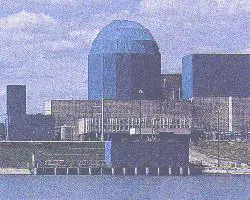What is Radiation and Radioactivity - Man-made sources of radiation
By EHSO.com, the site for free, objective, practical information about the environment, health and safety in 2024!
Translate this page to any language by choosing a language in the box below.
What is Radiation and Radioactivity - Man-made sources of radiation
What is Man-Made Radiation and Radioactive Materials
Since the discovery of radiation, people have benefited from the use of radiation in medicine and industry. Man-made sources of radiation account for about 20 percent of our total exposure to radiation
- Back to the main radiation page

RADIATION IN MEDICINE
Radiation used in medicine is the largest source of man-made radiation to which people in the United States are exposed. Most of our exposure is from diagnostic x-rays. Physicians use x-rays in more than half of all medical diagnoses to determine the extent of disease or physical injury. Radiation is also used in cancer treatments, where precisely targeted radiation destroys diseased cells without killing nearby healthy cells. Radiopharmaceuticals, another medical treatment, are used to locate tumors in a patient's body and to treat cancer. One-third of all successful cancer treatments involve radiation.

CONTROLLING THE RISKS OF MEDICAL RADIATION
The Food and Drug Administration (FDA) and other federal and state agencies regulate medical procedures that use radiation. EPA and these agencies also issue guidance designed to reduce unnecessary use of radiation in diagnosis and treatment and to ensure that technicians, equipment, and techniques meet standards that minimize radiation exposure.
Patients and health care providers must make the decision to use radiation on a case-by-case basis. Since any radiation exposure carries some risk, it is necessary to decide whether the benefits of radiation justify its use. Before receiving x-rays or any other type of medical treatment involving radiation exposure or dose, it is sensible to discuss the need for and benefits of the procedure and its alternatives with your physician.
NUCLEAR POWER
Nuclear power reactors, which use uranium, supply the United States with about 20 percent of its electricity. Our ability to produce power using radioactive materials reduces our reliance on fossil fuels. Nuclear power plant operations account for less than a hundredth of a percent of the average American's total radiation exposure. Workers at nuclear power plants receive higher doses of radiation, but the overall dose to the population is extremely low.


CONTROLLING THE RISKS OF NUCLEAR POWER
In 1979, EPA issued environmental standards that protect the public from radiation from the many kinds of facilities that contribute to the production of electricity through the use of nuclear energy. Additionally, in 1987, EPA issued guidance for Federal agencies to use in the development of radiation exposure standards for workers. These standards limit the amount of radiation that workers in medicine, nuclear power, industry, mining, and waste management may receive. Finally, in 1989, under the Clean Air Act, EPA published standards limiting radionuclide emissions from all Federal and industrial facilities.
The Nuclear Regulatory Commission (NRC) is the federal agency responsible for implementing EPA's radiation exposure standards through regulation of nuclear power reactors and many other uses of radiation. The Department of Energy (DOE) also implements these standards at facilities under their supervision.
Ways to save money AND help the environment:
Eat healthier AND save money: Instant Pot Duo Crisp 11-in-1 Air Fryer and Electric Pressure Cooker Combo with Multicooker Lids that Fries, Steams, Slow Cooks, Sautés, Dehydrates
Save water AND money with this showerhead adapter, it lets the water flow until the water is hot, then shuts off water flow until you restart it, ShowerStart TSV Hot Water Standby Adapter
Protect your health with these:
Mattress Dust mite-Bedbug protector, 100% Waterproof, Hypoallergenic, Zippered
Handheld Allergen Vacuum Cleaner with UV Sanitizing and Heating for Allergies and Pet, Kills Mite, Virus, Molds, True HEPA with Powerful Suction removes Hair, Dander, Pollen, Dust,
Immune Support Supplement with Quercetin, Vitamin C, Zinc, Vitamin D3
GermGuardian Air Purifier with UV-C Light and HEPA 13 Filter, Removes 99.97% of Pollutants
5 Stage Air Purifier, Features Ultraviolet Light (UVC), H13 True Hepa, Carbon, PCO, Smart Wifi, Auto Mode, Quiet, Removes 99.97% of Particles, Smoke, Mold, Pet Dander, Dust, Odors
Interesting Reads:
THE PREPPER'S CANNING & PRESERVING BIBLE: [13 in 1] Your Path to Food Self-Sufficiency. Canning, Dehydrating, Fermenting, Pickling & More, Plus The Food Preservation Calendar for a Sustainable Pantry
The Backyard Homestead: Produce all the food you need on just a quarter acre! Paperback
The Citizens' Guide to Geologic Hazards: A Guide to Understanding Geologic Hazards Including Asbestos, Radon, Swelling Soils, Earthquakes, Volcanoes
The Uninhabitable Earth: Life After Warming
Book: The Sixth Extinction: An Unnatural History Paperback
